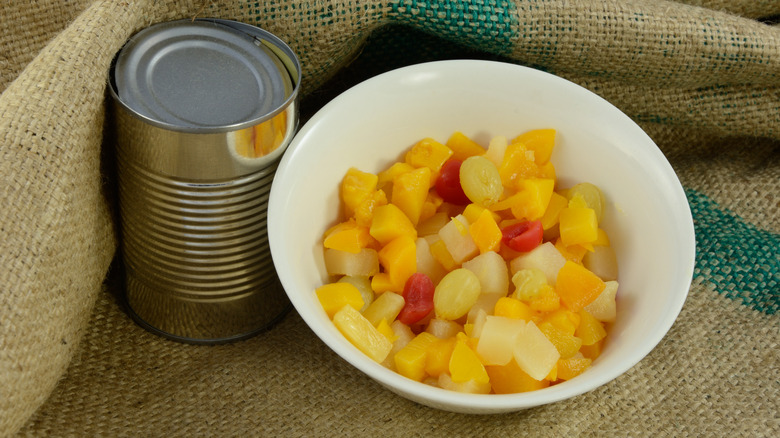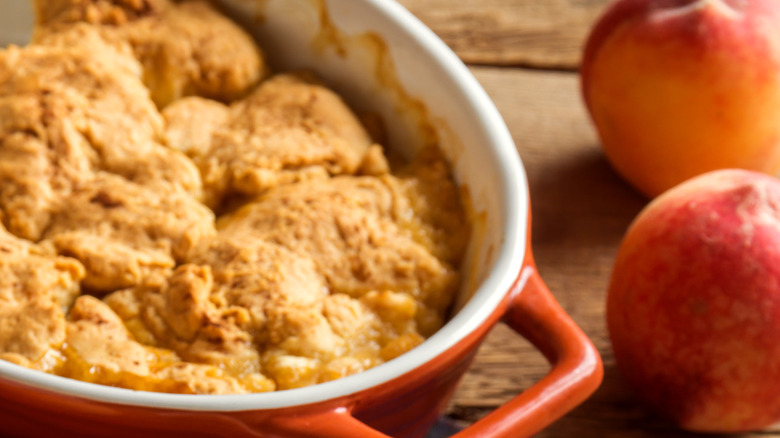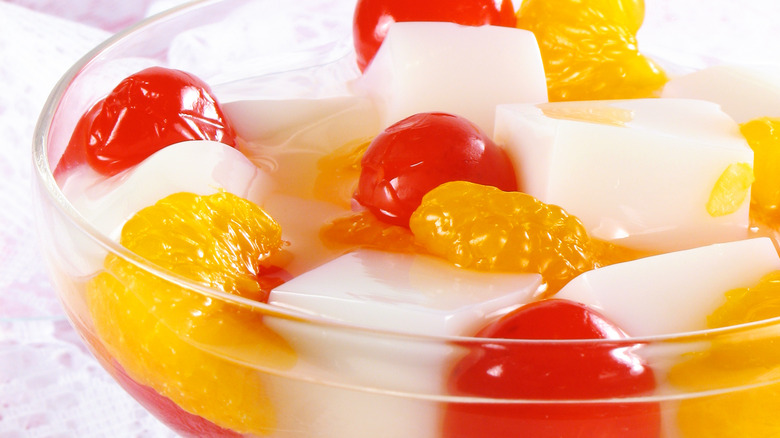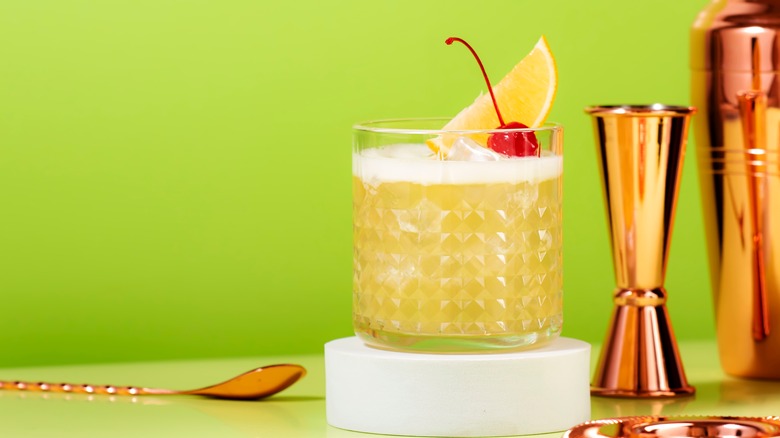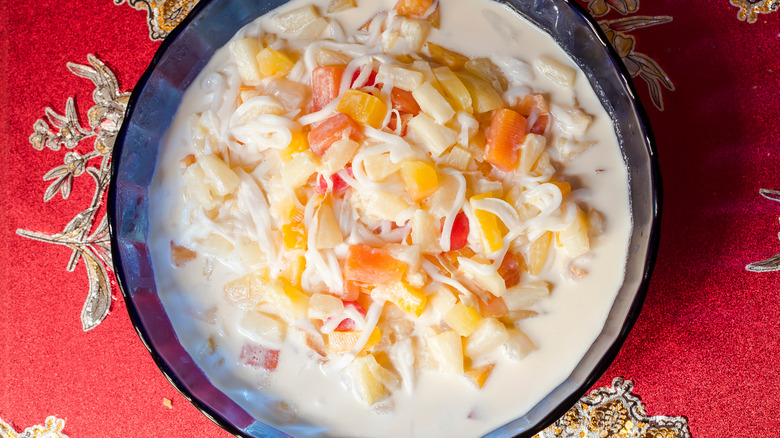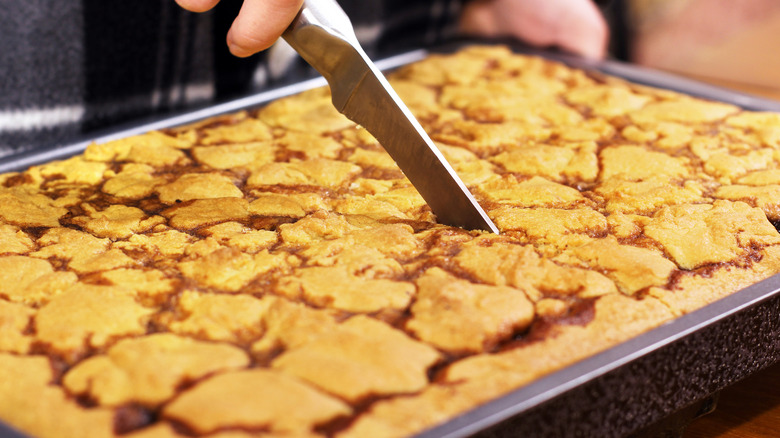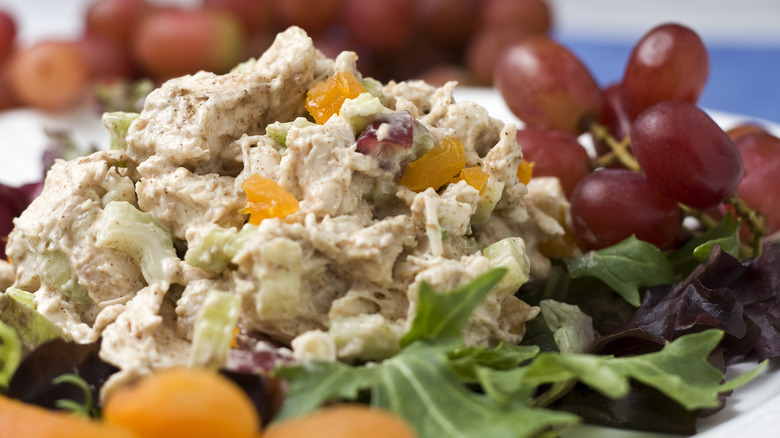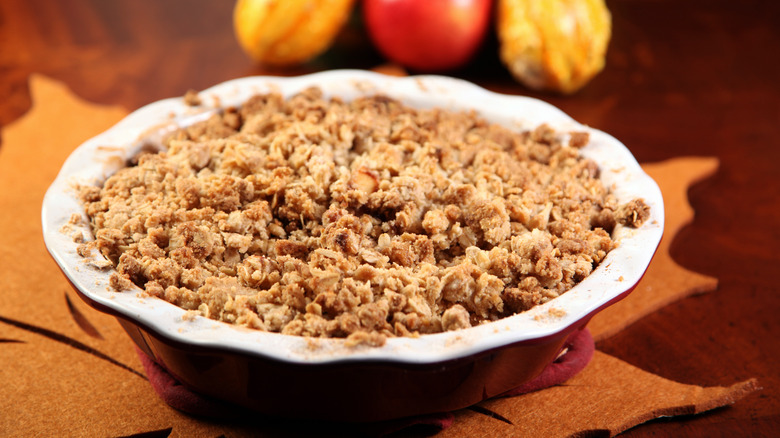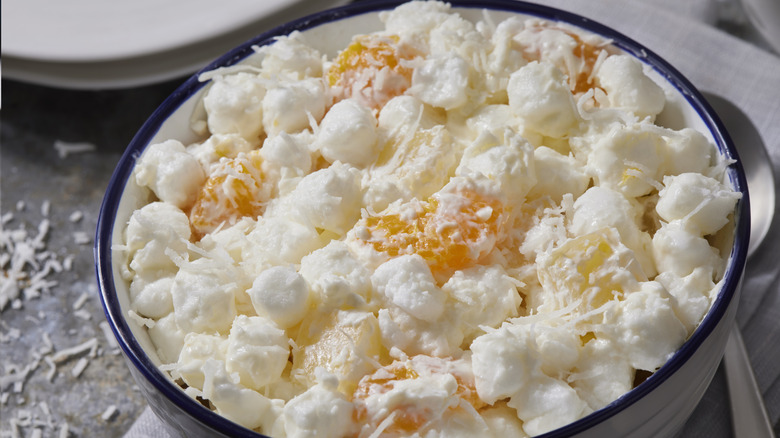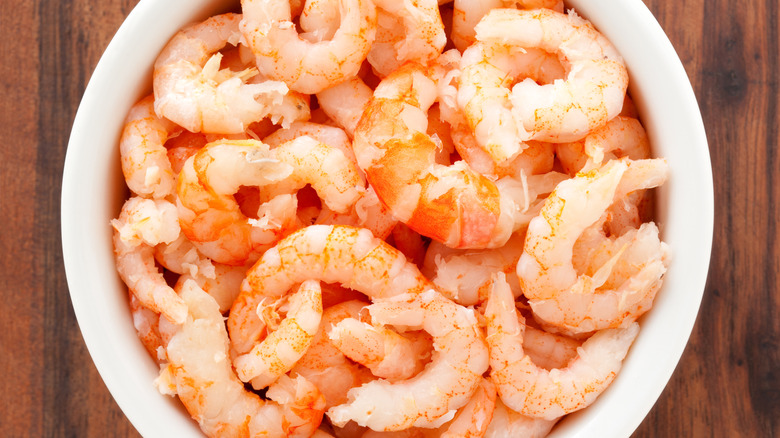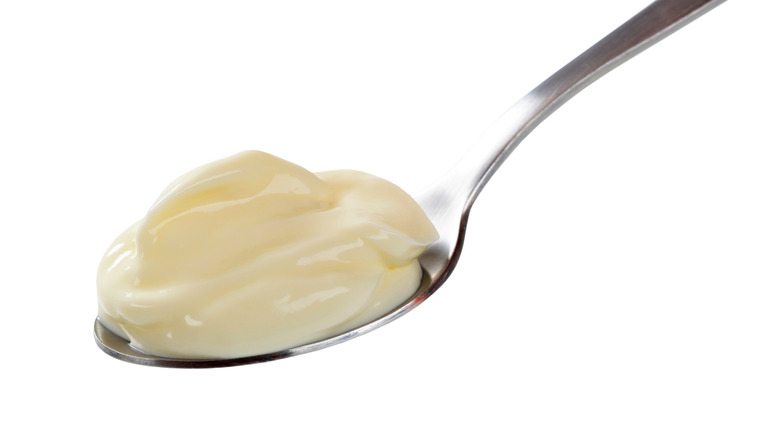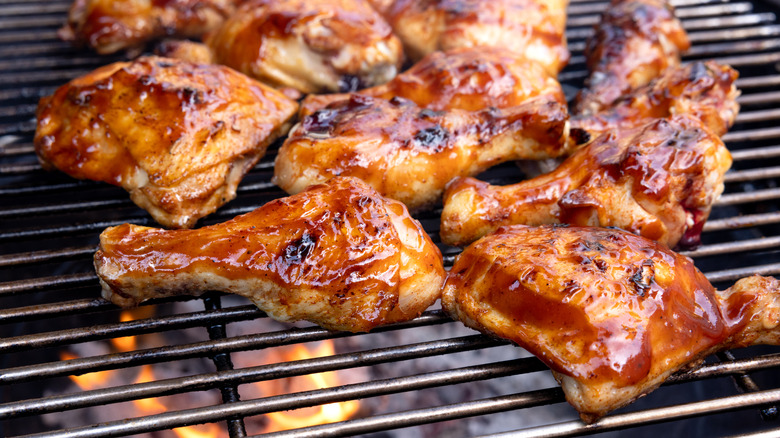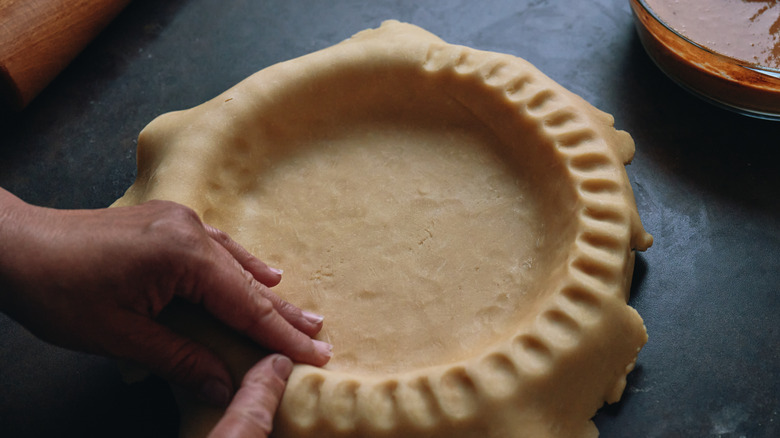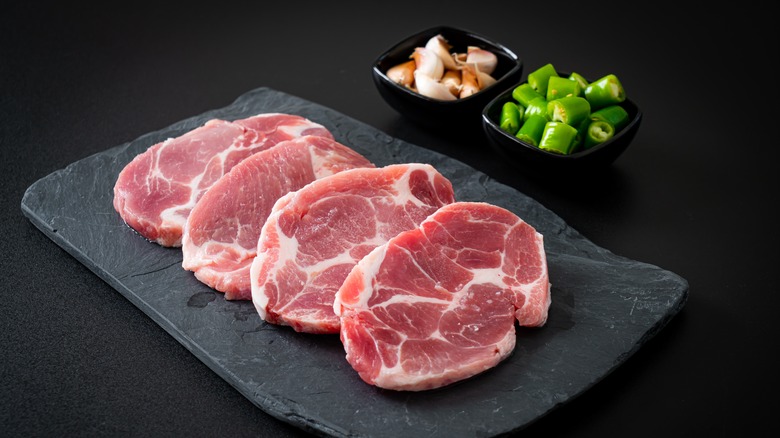15 Ways You Never Thought To Use Fruit Cocktail
Canned fruit cocktail seems like one of those foods that exist purely for the sake of convenience. Despite its evocative-sounding name, it contains no alcohol (though early recipes for homemade fruit cocktail were indeed laced with booze). It was invented in the 1930s in the fruit-packing region of northern California (which has since morphed into the Silicon Valley) by fruit growers and packers looking for a way to make use of edible, but slightly bruised or unattractive fruit.
Cutting off the wonky parts, cubing the rest, and canning everything as fruit cocktail proved to be a winning strategy as the product was had a global value of $23 million in 2022, according to DataIntelo. Contrary to urban legend, however, it's never been made from fruit scraps from the factory floor – even the fruit in fruit cocktail had to meet certain standards. Grapes not deemed up to snuff, for example, were historically passed on to Gallo to be used in wine.
While it's hard to imagine a time or place where canned fruit cocktail ever was (or will be) chic, it's become a dependable pantry staple and a common ingredient in home desserts. And it's more versatile than you think — you can do way more than simply fold it into a retro Jell-O mold. Here are some unexpected ways you can use it.
Mixed fruit cobbler
Fruit cobblers are humble, but always welcomed, desserts, and it's easy to see why: The combination of juicy fruit and tender, cakey topping (which often absorbs some of the flavorful fruit juices) is classic and irresistible. Cooks love cobblers because they're versatile and easy – you can use any fruit that's in season, and if the finished dish doesn't look Instagram-perfect, no one will care. (And if there are any leftovers, they'll make a great breakfast the next morning.)
But what if you want to make fruit cobbler but don't have any fresh (or even frozen) fruit around? No problem – this is where that can of fruit cocktail that's been languishing in your pantry can take a star turn. You can top fruit cocktail with your favorite cobbler batter and bake, but some versions are even simpler.
Dolly Parton is often credited with the dessert and uses just three ingredients: a can of fruit cocktail with its liquid — either the traditional variety with sugar syrup or lighter versions with just fruit juice will work, a cup of self-rising flour, and a cup of sugar. These are then baked in a greased casserole. And, like almost all cobblers, it tastes even better served with a scoop of ice cream.
Almond jelly
Canned fruit cocktail is the traditional accompaniment to the old-school Chinese restaurant dessert, called almond jelly. The treat consists of soft cubes of milky, almond-flavored jelly served with fruit cocktail. Traditionally, making it was a painstaking task that involved boiling and grinding the kernels of apricot pits (which have an almond-like flavor and aroma) and cooking them with sugar and agar-agar, a jelling agent made from seaweed.
Today, however, most cooks use milk and regular powdered gelatin as the base and almond extract for flavoring, making this a super-easy dessert to make. Like other jelled sweets, almond jelly is a great make-ahead dessert. And because it's cool, light, and not too sweet, it's a good choice for a casual summer party. The fruit cocktail adds both flavor and a colorful visual contrast to the simple sweet. And no, the appearance of the all-American canned fruit cocktail in a traditional Chinese dessert isn't as odd as it sounds. Canned American foods are common and popular in the Philippines and other parts of Asia, where products such as condensed milk and Spam make regular appearances in home pantries and meals.
Whiskey cocktails
For some eaters, the problem with fruit cocktail is it looks and feels like kid food. Sure, it's pleasant enough to eat, but it's not something you want to be seen eating if you're trying to make a grownup impression — say, during a business lunch. Not that there's anything wrong with sweet, colorful, fruity preparations, of course. It's just too bad fruit cocktail couldn't be more like, well, a real adult cocktail.
Well, there's no reason why it can't — after all, in the 19th century, cooks regularly added wine and other alcoholic drinks to fruit salads for an added punch. And today's fruit cocktail can serve as the base for a very grown-up punch. To make it, drain a can of fruit cocktail, reserving its juices, and then macerate the fruit in whisky overnight. When you're ready to serve, combine the reserved syrup with a 12-ounce can each of peach and pear nectar, add the fruit and whisky, and serve over ice.
Buko salad
Fruit cocktail in a salad may sound like the most middle American thing imaginable, but it also evolved independently in the Philippines — where it has been enthusiastically embraced. The fondness for fruit cocktail (and other American canned products) there is rooted in the country's period of American colonization and military occupation at the turn of the 20th century. During this time, American military personnel brought their own canned foods to the Philippines, distrusting local foods — and soon, Filipinos developed a taste for these canned foods as well, incorporating them into their own dishes and inventing completely new ones to showcase them.
Among these innovations is buko salad, which can best be described as something like a rich tropical ambrosia. At its heart is drained, canned fruit salad (and other canned fruits such as peaches and lychees) enriched with a saucy dressing of condensed milk and cream. What makes it distinctly Filipino, however, are its other ingredients — shredded young coconut (buko), canned palm fruit, coconut jelly, and sometimes even cubes of cheese or corn kernels. It's a popular party dish in the Philippines, and if you have a well-stocked Asian market near you, it's an easy and fun way to change up your fruit cocktail game.
Southern fruit cocktail cake
Fruit cocktail may not have a glamorous reputation, but its many underappreciated characteristics make it a great addition to baked goods — it's not only pretty and colorful, but its distinctive tutti-fruity flavor can contribute a welcome and unexpected flavor profile to a routine bake. For instance, it can transform a standard yellow cake into something completely new and different, like Southern fruit cocktail cake. Fruit cocktail has long been embraced in the American South, as has creative cake making, so it was no surprise the two would eventually come together.
Many versions exist, but among them is a straightforward sheet cake of self-rising flour, fruit cocktail (and its juices), eggs, sugar, and vanilla. To make the cake, just mix the ingredients together and bake in a rectangular baking pan. To make this simple but flavorful cake even more memorable, top it with a rich sauce of butter, sugar, evaporated milk, coconut, and pecans. Briefly cook this mixture together to combine and warm. To serve, prick the still-warm cake with a fork or skewer and slowly pour over the sauce.
Fruity chicken salad
Newsflash: Fruit cocktail isn't just for dessert. While its intense sweetness makes it a natural addition to sweet dishes, some traditionally savory dishes can benefit from a hit of sweetness too. Among these is chicken salad, which can be either fully savory or can fold in some sweet notes. For instance, coronation salad — a curried chicken salad famed as the featured lunch dish at the late Queen Elizabeth II's coronation – features sweet accents including mango chutney and dried apricots.
Fruit salad can play the same role as these sweet additions in another variant of chicken salad. To make it, toss the drained fruit cocktail with shredded chicken, chopped apple, chopped celery, slivered almonds, and a pinch of salt. A simple creamy dressing of softened cream cheese blended with mayonnaise brings everything together. It makes a great buffet or brunch dish if you're looking to surprise your guests with a twist on an old favorite.
Marinade
A big part of every can of fruit cocktail is the copious quantity of liquid in which the fruit has been cooked and stored. Traditionally, this was a heavy sugar syrup, but as consumer demand rose for more healthful options, new versions of fruit cocktail emerged featuring pure fruit juice or lower quantities of sugar. Nevertheless, most people typically drain off the liquid before emptying the fruit into a serving dish.
While you may not want to slurp up a bunch of syrup with your fruit — or see it sloshing around your serving dish – dumping the canning liquid is a lost opportunity. This liquid has a lot of flavor which can be put to good use in other dishes. For instance, it can be incorporated as a fruity accent to a marinade for meat or chicken. As a plus, the liquid from fruit cocktail varieties with high proportions of pineapple act as meat a tenderizer, making your marinated meat not only more flavorful but even more pleasant to eat.
Fruit cocktail crumble
If you've always been a fan of fruit cocktail but occasionally feel a need to dress it up a bit, try a fruit cocktail crumble. This dish is a great way to showcase everything you love about the fruit without a whole lot of extra work. It's easy and fast to make — pour the fruit cocktail into a baking dish and top it with a crumbly topping of self-rising flour, butter, sugar, and a touch of salt. Be sure to spoon on the topping so it's slightly heaped in the middle and lower around the edges — this gives the finished crumble both a better texture with a nice bit of crunch as well as a more attractive appearance. Then bake the crumble until the crumbs are golden brown. The contrast between the warm, soft fruit and the crisp, buttery topping turns ordinary fruit cocktail into something completely new.
Fruit cocktail crumble is easy enough to be a first baking experience for any children in your life, and quick enough to make a good weeknight dessert. To make it even better, serve it with vanilla ice cream (or for a British touch, custard sauce). It's almost as easy as just opening a can of fruit cocktail — and a lot more rewarding to eat and share.
Fruit cocktail salad
Close watchers of American foodways know that the word "salad" can mean very different things, depending on who you ask and where they were raised. For some, the first thing that comes to mind is a healthful lunch of quinoa and microgreens. But for others, it brings to mind colorful Jell-O molds and not-even-pretending-to-be-healthy concoctions such as Snickers salad (yes, that's a thing).
Fruit cocktail salad falls squarely into the latter category — it's closer to a dessert than something you'd typically enjoy as a starter or a side dish. For starters, the dressing isn't a light lashing of fruit juice or a yogurt-based mixture, as is common for other fruit salads, but a thick, sweet mixture of instant pudding mix and whipped topping. And, besides the fruit cocktail and potentially other fruits (such as canned mandarin oranges or sliced bananas), it can also contain other sweet add-ins such as marshmallows. This salad is definitely not diet food — but it could be a fun family dessert if you're trying to coax your kids into eating more fruit.
Muffins
When the itch to bake hits, time-pressed home bakers often turn to muffins. They're not only easy to make, requiring little more than a bowl, a spoon, a muffin tin, and a handful of common pantry ingredients, but they make great snacks or on-the-go-breakfasts that everyone loves. And, experienced cooks know that almost anything can go into a muffin, from classic sweet flavors such as blueberry and apple to savory versions featuring cheese, bacon, ham, and more.
With their nearly endless versatility, muffins can also be a great backdrop for fruit cocktail – the tiny morsels of cubed fruit are just the right shape and size to add attractive color and flavor accents to a fluffy breakfast muffin. After thoroughly draining your can of fruit cocktail, fold it into a muffin batter made with vanilla Greek yogurt, then spoon it into greased muffin tins, and bake. If you're new to muffin-baking, remember the key to success is to barely mix the batter – it should still look a bit lumpy when you spoon it into the muffin cups. Oh, and don't be tempted to overfill the muffin cups, either. The muffins will rise as they bake, so fill the cups only about two-thirds full. Then, sit back. It won't be long before a batch of fresh, hot, fruity muffins will be yours to enjoy.
Seafood salad
The rules dictating which foods go together (or don't) are fluid. It wasn't that long ago that now-standard flavor combos like salted caramel or chocolate with chiles would have struck most mainstream American diners as downright bizarre. And today, the idea that the sweet mincemeat in our Thanksgiving pies was historically made from actual meat sounds equally bizarre. What this all means is there are plenty of potential ways to combine ingredients that cultural barriers keep us from considering.
Consider, for example, cold seafood salad with fruit cocktail, which is a favorite starter at Hong Kong banquets. This is a creamy, juicy, crunchy blend of freshly cooked, chilled jumbo shrimp and drained fruit cocktail tossed in a creamy sauce of mayonnaise and a touch of condensed milk.
Yes, it sounds like some sort of crazy joke. But, when you consider the super-sweet, fruity sauces often served with coconut shrimp and other seafood preparations, the actual combination of flavors in this seafood salad is not that weird. Plus, the mixture of seafood, fruit, and a creamy binder also shows up in some versions of tuna salad. So, give this dish a shot if you're feeling adventurous — you might be pleasantly surprised.
Filipino maja blanca with fruit cocktail
Filipino cooks have embraced fruit cocktail for years, creating unique recipes that showcase both its sweet fruitiness and local ingredients and culinary traditions. Among the distinctly Filipino dishes that showcase fruit cocktail is maja blanca, a sliceable coconut confection thickened with cornstarch. This recipe exemplifies East/West culinary fusion at its best. Originally inspired by a milk-based Spanish dessert, manjar blanco, Filipino cooks swapped out the dairy for coconut milk and added local flavorings such as ube (purple yam) or pandan — and later, fruit cocktail.
Maja blanca is a stovetop dessert, made by heating together coconut milk, evaporated milk, condensed milk, sugar, and drained fruit cocktail, then whisking in a slurry of cornstarch and the liquid drained from the fruit cocktail can. The mixture is then cooked until shiny and thickened to the consistency of mashed potatoes, then spooned into molds. Additional fruit cocktail is arranged decoratively on top of the molds before the mixture firms as it cools. Then cooled dessert is served in slices.
Barbecue chicken
Fruit cocktail also makes a surprisingly harmonious addition to barbecue sauce. This shouldn't be surprising, since sweet, fruity ingredients such as peach jam and pineapple juice commonly find their way into grill sauces. And, the sweet-savory flavor of meat glazed with a fruit sauce caramelized on the grill is a cherished part of summer dining.
You can make fruit cocktail the star player in your next batch of barbecue sauce without your guests even knowing. Simply blend a can of fruit cocktail with other standard barbecue sauce ingredients – ketchup, vinegar, mustard, smoked paprika, cayenne, salt, and pepper — and simmer until thickened. Brush generously onto chicken pieces once they're nearly done grilling, and continue cooking until attractive grill marks form. Top with additional sauce if desired (or serve with sauce on the side). The fruit cocktail not only adds a vibrant flavor but adds depth and thickness to the finished sauce.
Fruit cocktail pie
Fruit cocktail can fit in pretty much anywhere other cooked fruit can, which means there's no reason not to put it in a pie. Even better, you're not limited to just one style of pie. Depending on your mood and your tastes, you can showcase your fruit cocktail either in a traditional two-crust pie that can be served warm or cold, or in a single-crust, no-bake pie in which the fruit cocktail is folded into a creamy filling.
One way to approach these is to think of the double-crust pie as a winter dessert and the open-face pie as a summer dessert. In the double-crust pie, the fruit cocktail is thickened with cornstarch and flavored with butter and cinnamon before being poured into the bottom crust, topped with the second crust, and baked. In the single-crust pie, condensed milk, lemon juice, whipped topping, maraschino cherries, and fruit cocktail are folded together, piled into a graham cracker crust, and chilled until firm and sliceable. Whichever option you choose, you'll have a deliciously different way to enjoy fruit cocktail.
Pork chops with fruit cocktail
Pork is often cooked and served with fruit, as seen in classic dishes such as pork braised with prunes and pork chops served with applesauce. And, of course, a fruity barbecue sauce is a natural pairing with pork. So, this means fruit cocktail will be a great match for most things pork as well. Indeed, a number of cooks have discovered clever ways to use fruit cocktail to make their weeknight pork chops into something memorable.
A super-basic strategy, great for family dinner on a busy night, is just to salt and pepper your pork chops, bake them halfway in a shallow baking pan, then top with fruit cocktail and brown sugar and continue baking until done. For a more sophisticated take, try tamarind fruit cocktail pork chops. This, more elaborate and complexly flavored dish, starts with breaded and fried pork chops served with a sauce of tamarind concentrate, soy, and fruit cocktail (along with its syrup) thickened with cornstarch. Tangy, sweet, and savory all at once, it's a fun twist on classic sweet-and-sour pork.

